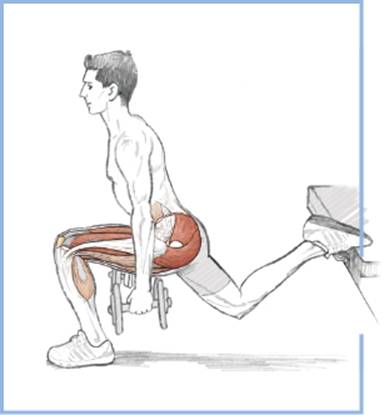There is no real division between the core and the upper leg; all the limbs merge seamlessly into each other. Some of the pelvic muscles help movement and stability of the leg, and vice versa. The same occurs at the knee, where muscles are described as crossing over two joints, so they influence the action and steadiness of the joints. The upper leg (figure 8.1), or femur, is inserted via the hip joint into the pubis and ischium. The other bone of the upper leg, the patella (knee joint), is really a pulley. It runs in a groove at the lower end of the femur to help guide the extending forces of the quadriceps muscles around the knee.
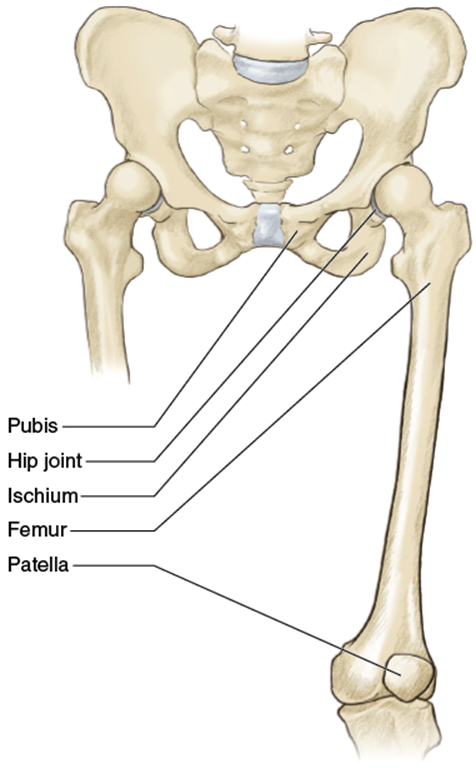
Figure 8.1 Bony structures of the upper leg.
The primary function of the quadriceps group (figure 8.2a) is to extend the knee. From the outside to the center line, the vastus lateralis, rectus femoris, vastus intermedius, and vastus medialis combine at the superior pole of the patella and straighten the knee joint with a pull through the patellar tendon on the upper part of the tibia. Contraction of this, the largest muscle group in the body, also pulls the knee toward the chest. It is particularly relevant to the sprinter, who gains extra stride length with big quadriceps contractions; however, this high knee lift wastes energy in a long-distance run, so the hip and knee have much smaller ranges of motion when covering longer distances. The role of the quadriceps in the running action is therefore twofold, though the intent of both movements is to increase the stride length (see figure 3.2 on page 23). If at the same time the knee is fully extended and the quadriceps muscles exert the maximum flexion to the hip, not only is the stride length maximized, but the added time in the air will also allow the momentum already generated to propel the body farther forward.
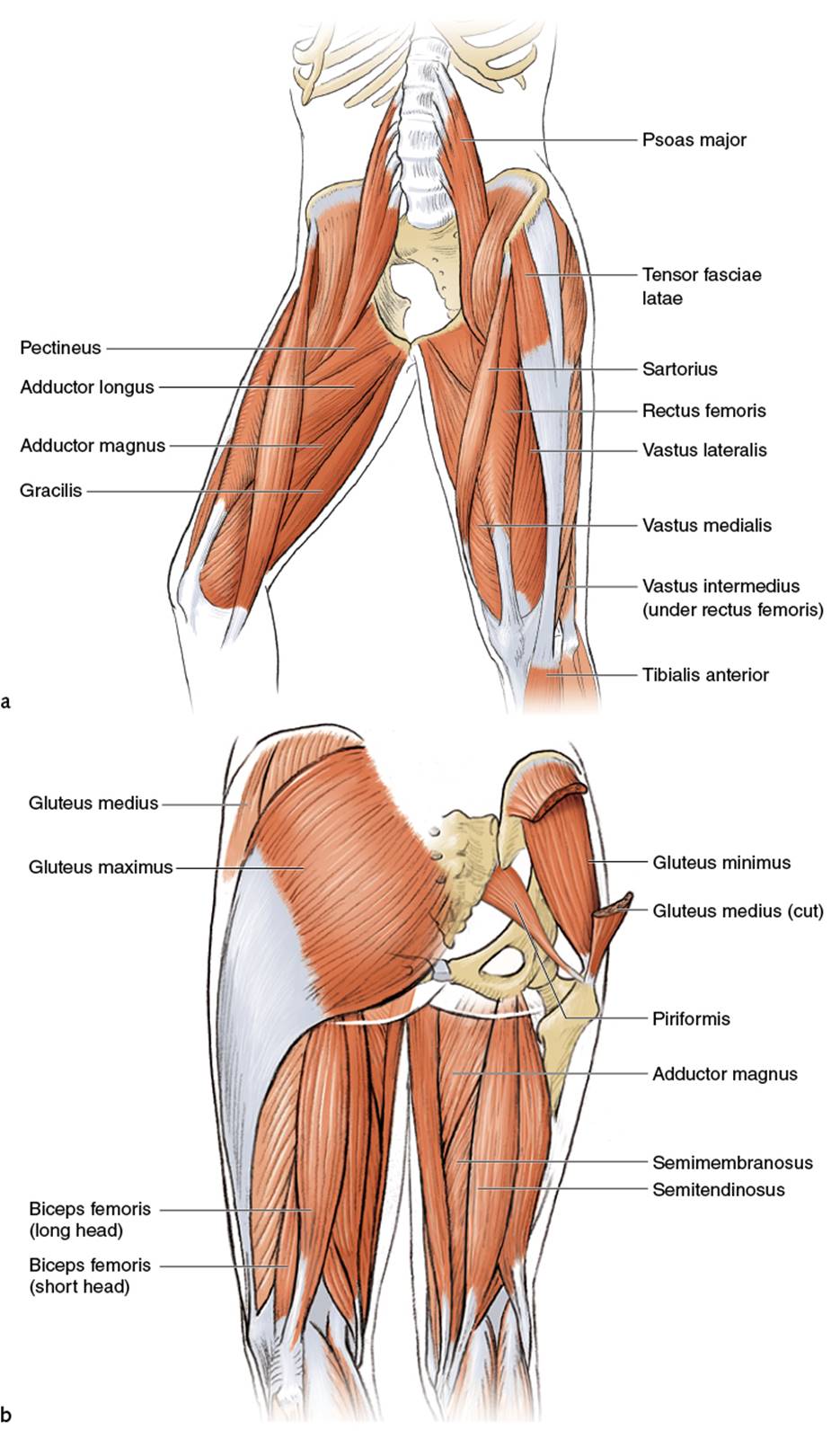
Figure 8.2 Upper leg: (a) front and (b) back.
Much the same goes for the hamstring muscles (figure 8.2b), which also span the two joints but act in an opposite manner to both extend the hip and flex the knee. The semimembranosus, semitendinosus, and biceps femoris have some congruity in the center of their bulk, having arisen from different points within the pelvis, but then separate behind the knee and are inserted into the rear of the tibia and fibula. Contraction of the hamstrings drives both the upper and lower leg backward, a movement that tends to be exaggerated in a sprinter (see figures 3.3 and 3.4 on pages 24 and 25). Increased knee flexion would be inefficient to a distance runner; a greater percentage of the hamstring motion for a distance runner occurs at the hip.
It may be helpful to consider each full hamstrings group as two separate half muscles. This may sound paradoxical, but although it is the upper portion that links over the hip joint as an extensor muscle, the lower portion both flexes and limits extension of the knee. There is, of course, no actual physical distinction within the muscle groups when they are microscopically examined; the difference is purely functional. In the distance runner the hamstrings have a limited range of motion over both the hip and knee joint, although their contraction is very powerful over these small angles.
It may seem strange that the knee needs to be able to twist, but how else would a runner turn corners or cope with uneven terrain? The knee (figure 8.3) has two collateral ligaments on the inside and outside that allow it to hinge to and fro, but rotation depends on the half-moon-shaped menisci, also known as cartilages, which are placed between femur and tibia and spread weight through the knee joint. They also allow the bones to twist on each other. An anterior and posterior cruciate ligament within each knee, placed in a crosslike shape, obstruct excessive forward and backward movement of femur and tibia on each other. It should be stressed, however, that these ligaments are there to guide knee movement and play only a small part in maintenance of knee stability, which depends mostly on the strength of the muscles.
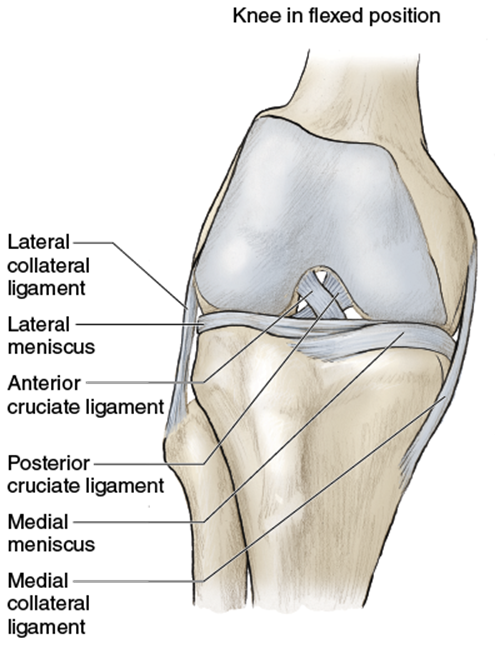
Figure 8.3 Knee ligaments and tissue.
The thigh muscles need both strength and flexibility, each of which can be improved by exercise. The maintenance of a balance between the two is also vitally important because being muscle-bound will do little for pliability; the converse is equally true in that lack of muscle bulk will cause relative weakness.
Specific Training Guidelines
Protection of the knee joint while performing some of the following upper leg exercises is an important consideration. Because both the quadriceps and hamstrings groups of muscles attach to the knee, and the knee joint twists to adapt to terrain variations, turns, uphills, and downhills, there is constant stabilization and relaxation of the joint. The lunge exercises are difficult to perform initially, so care must be taken to perfect the motion with lighter weight before increasing the resistance. A machine-aided exercise helps protect the joint, but it has a fixed range of motion that does not make it the best functional exercise.
The exercises listed for the upper legs are good introductory and strength (threshold) phase exercises. However, they should not be done during the final phase of training, which emphasizes VO2max. During the final phase, substitute the plyometric exercises listed in chapter 12 to meet a runner’s needs without overly fatiguing the muscles.
![]()
Hip Adductor Machine

Technique Tip
•Avoid pushing the weight with the feet. Focus on bringing the legs together with the adductor muscles.
Execution
1. Sit in a proper seat position, with machine pads on the insides of the knees.
2. Squeeze inward on the pads. The motion should be fluid but with consistent effort throughout.
3. Return to the original position by gradually resisting the weight.
Muscles Involved
Primary: adductor longus, adductor brevis, adductor magnus, gracilis
Secondary: vastus medialis
Running Focus
The adductor exercise can be used in a strength-development regimen or as a rehabilitative regimen that requires ancillary muscles to be developed without undue stress on the knee joints. Many knee problems are caused by an imbalance of the four quadriceps muscles, which cause tracking issues for the patella. The adductor exercise strengthens the adductor muscle group specifically and the vastus medialis secondarily, preventing the patella from tracking too laterally. Developing strength in the adductor group and the quadriceps muscles of the upper leg aids in the powerful extension during the propulsive phase of the running gait. To prevent imbalances in the quadriceps, perform the abductor exercise on the same piece of equipment, as described in chapter 7.
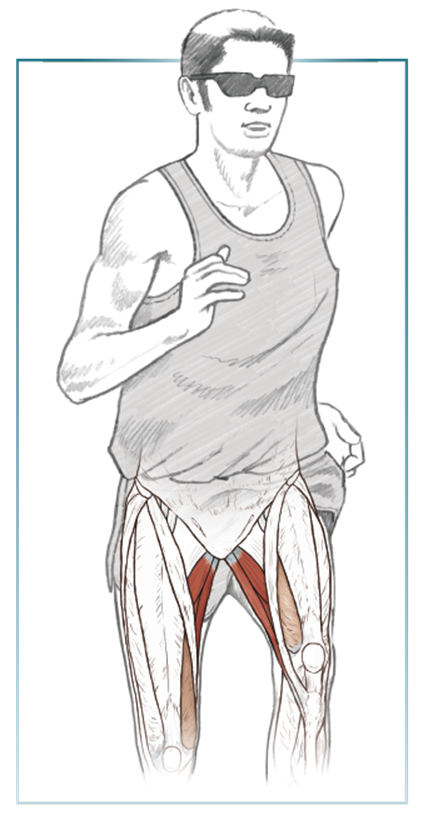
![]()
Machine Leg Extension
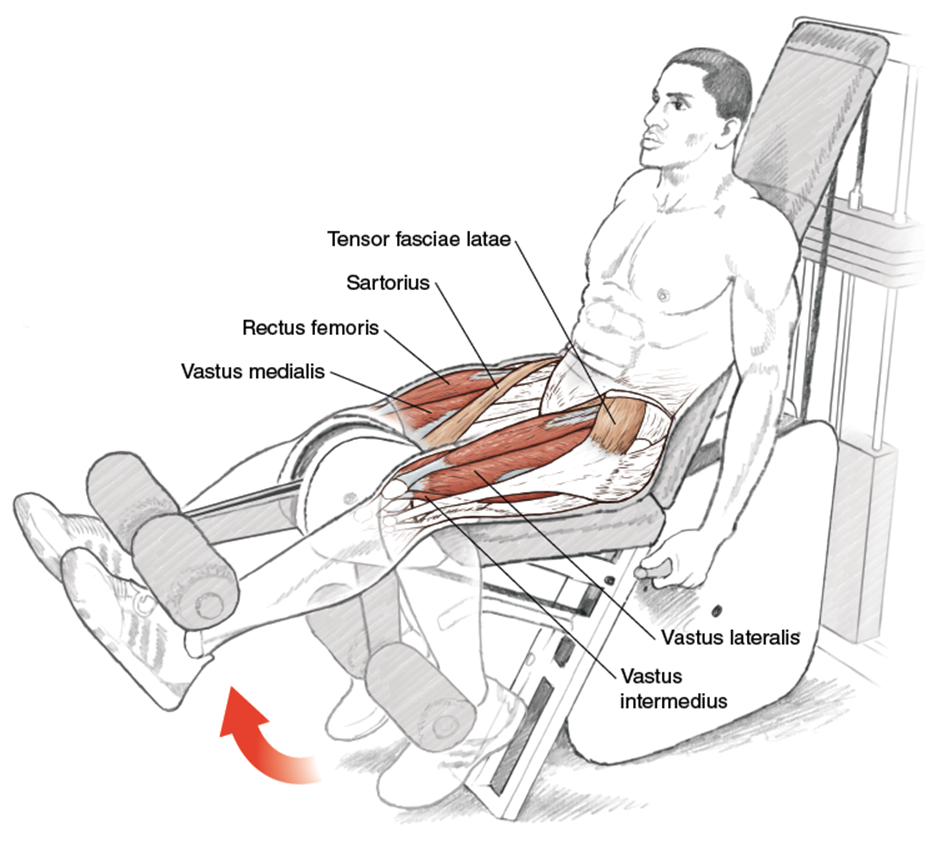
Technique Tip
•Avoid hyperextending the knees and rocking the body to help lift the weight.
Execution
1. Sit in the leg extension machine in the appropriate position. Keep the knees in line with the fulcrum of the weight lever and the back straight. Grasp the handles on both sides of the seat, but do not squeeze.
2. After choosing an appropriate weight, extend, but do not hyperextend, both legs through a full range of motion with a fluid motion.
3. At full extension, lower the legs gradually, resisting the weight while inhaling deeply.
Muscles Involved
Primary: quadriceps
Secondary: tensor fasciae latae, sartorius
Running Focus
The machine leg extension is a fantastic exercise because it is simple to perform and has a great impact on quadriceps strength. It develops the four muscles of the quadriceps equally (rectus femoris, vastus lateralis, vastus medialis, and vastus intermedius) and aids in keeping the patella tracking correctly. For runners suffering from a patellofemoral injury, the full extension needed for this exercise will unduly stress the patella. To help develop the quadriceps, a modified version of the exercise using a short arc (only the final 15 to 20 degrees of the exercise) helps off-load the patella. This exercise is a must during the introductory phase of training due to its general strength-building power.
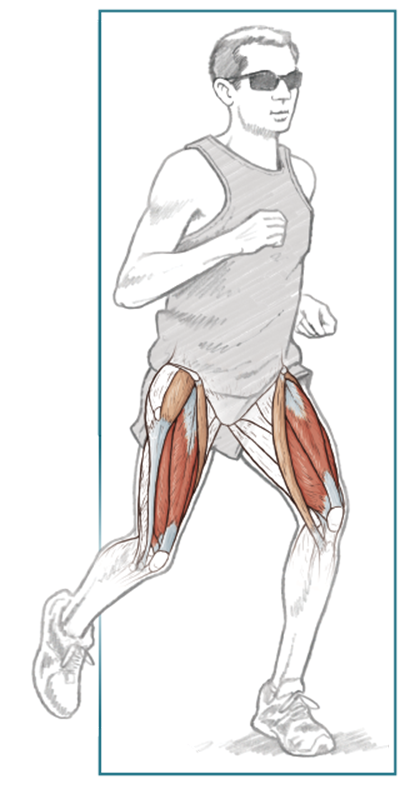
Variation
Machine Leg Extension With Short Arc
The leg extension with short arc variation is an excellent exercise for developing quadriceps strength if there is knee pain due to patellofemoral syndrome. The only drawback is that it is not a full range-of-motion exercise; however, once the knee pain dissipates, the full extension exercise can be completed.
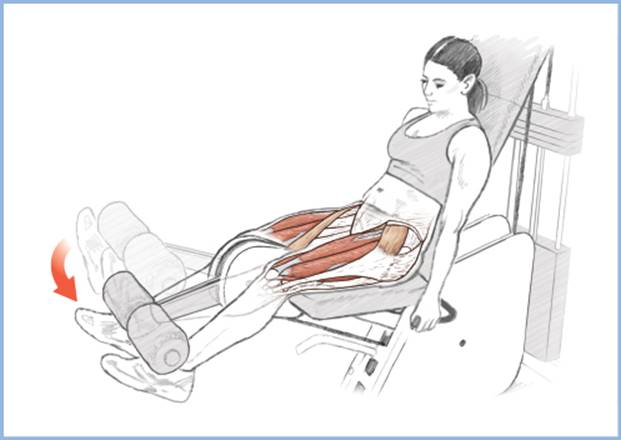
![]()
Machine Lying Hamstring Curl
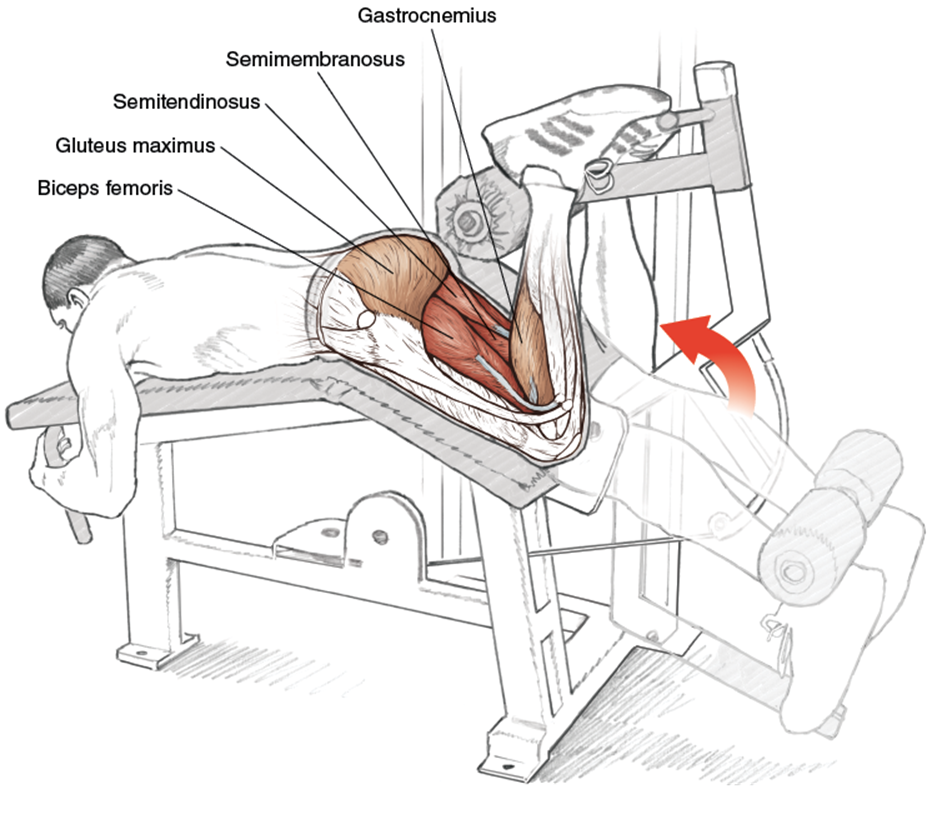
![]()
Safety Tip
Some common mistakes made while performing this exercise are pulling strongly on the handles to help aid the motion of the exercise, lowering the weight too quickly, and slamming the weight into the glutes to finish the repetition.
Execution
1. Lie prone on a hamstring curl machine. The pads of the machine are situated at the Achilles tendon. Hands are outstretched, holding onto the handles of the bench. Keep the head centered with the chin slightly off the bench.
2. Focusing on the hamstring muscles, slowly but fluidly pull the weight upward.
3. Return the weight to the starting position by gradually resisting the downward motion of the lever.
Muscles Involved
Primary: hamstrings
Secondary: gluteus maximus, gluteus minimus, gastrocnemi
Running Focus
As the counterpart to the machine leg extension, the lying hamstring curl works the large muscles of the hamstrings, helping to balance the quadriceps muscles of the front of the leg. The hamstrings come into play during the recovery phase of the gait cycle, as the lower leg bends at the knee, pulling the leg upward toward the glutes. The hamstrings group is not as strong as the quadriceps group, but it must be diligently strengthened or an imbalance between the quadriceps and hamstrings could occur. It is not common for distance runners to experience hamstring tears or pulls, but it is common for distance runners to suffer from hamstring tightness because of problems in the lower back. Also, many knee injuries are related to weak hamstrings.
One complaint about the hamstring curl is that it works only the hamstrings and not the hamstrings and glutes, which work together in the gait cycle. While true, this is less significant if the exercise is performed in the base, or introductory, phase of training, where the emphasis is more on general strengthening and less on functional work, and where other exercises can work the glutes.
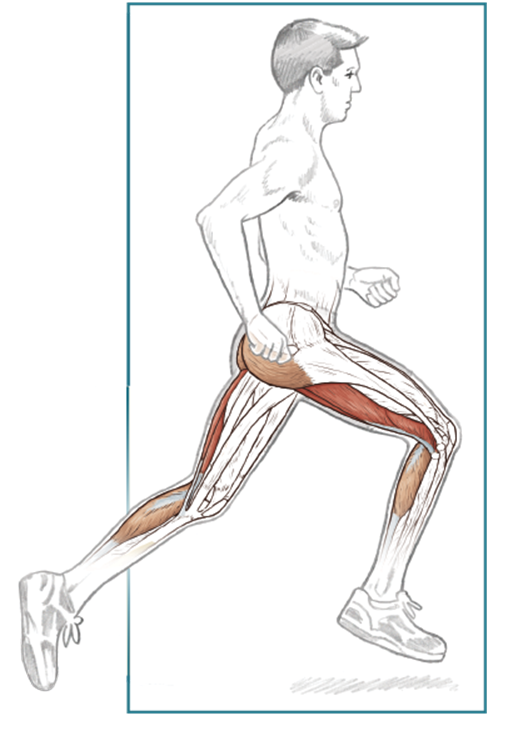
Dumbbell Lunge
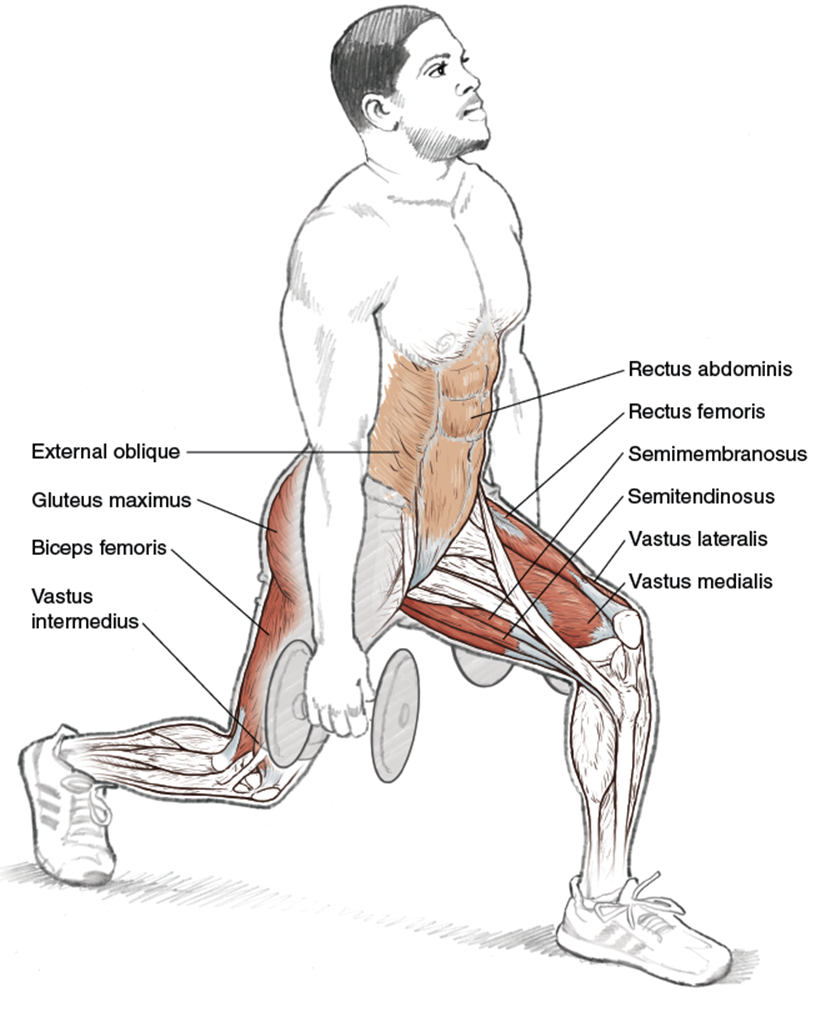
![]()
Safety Tip
One caution for this exercise is to not allow the kneecap to extend past the toes of the lead foot while performing the movement. The possibility of injuring the knee because of its relatively vulnerable, unstable position while performing a difficult, anaerobic exercise is real. This is a wise rule to follow for most people; however, in a few runners with longer femurs, it is difficult not to extend past the toes. Practice the exercise in front of a mirror, and if your form is spot-on and your knees extend past your toes, so be it.
Technique Tip
•Do not attempt too much weight when first performing the exercise. Balance and flexibility play a large role in performing the movement, so practice good technique before adding weight.
Execution
1. Stand with legs shoulder-width apart, with good posture. Each hand is holding a dumbbell that is relatively light.
2. Take a small step forward with one leg, lowering your hips as you step so that your quadriceps are parallel to the ground and your lower leg is at a 90-degree angle at the knee. Your rear leg provides balance.
3. Return to the original position by pushing upward, after reaching parallel, with the same leg that made the initial step. Repeat the exercise for a full set of reps on one leg, or switch legs after a rep with each leg.
Muscles Involved
Primary: quadriceps, hamstrings, gluteus maximus
Secondary: rectus abdominis, external oblique
Running Focus
The lunge is a difficult exercise to master quickly. Like the squat, a similar movement, it develops strength throughout the core, hamstrings, and quadriceps, but mastering the proper form is difficult. It is important to master the technique before adding weight. A barbell instead of dumbbells can be used, but holding the barbell on the shoulders is an unnatural hand position for a runner. Keeping the hands low while holding the dumbbells is normally more comfortable for runners.
This exercise fits nicely in the second, or strength (threshold), phase of training. It is functional and, with the added weight of the dumbbells, can develop significant strength.
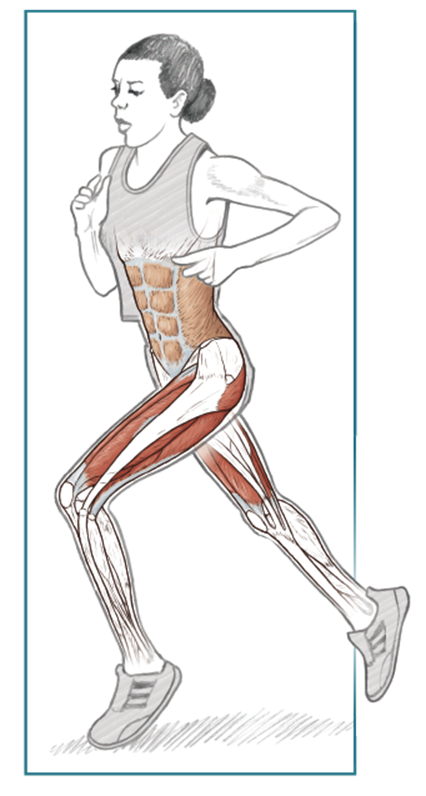
Variation
Lunge With Long Step
By taking a longer step, the gluteus medius and gluteus maximus of the leg that is forward are strengthened more than with a regular step, and the iliopsoas and rectus femoris of the back leg are stretched.
Machine Incline Leg Press
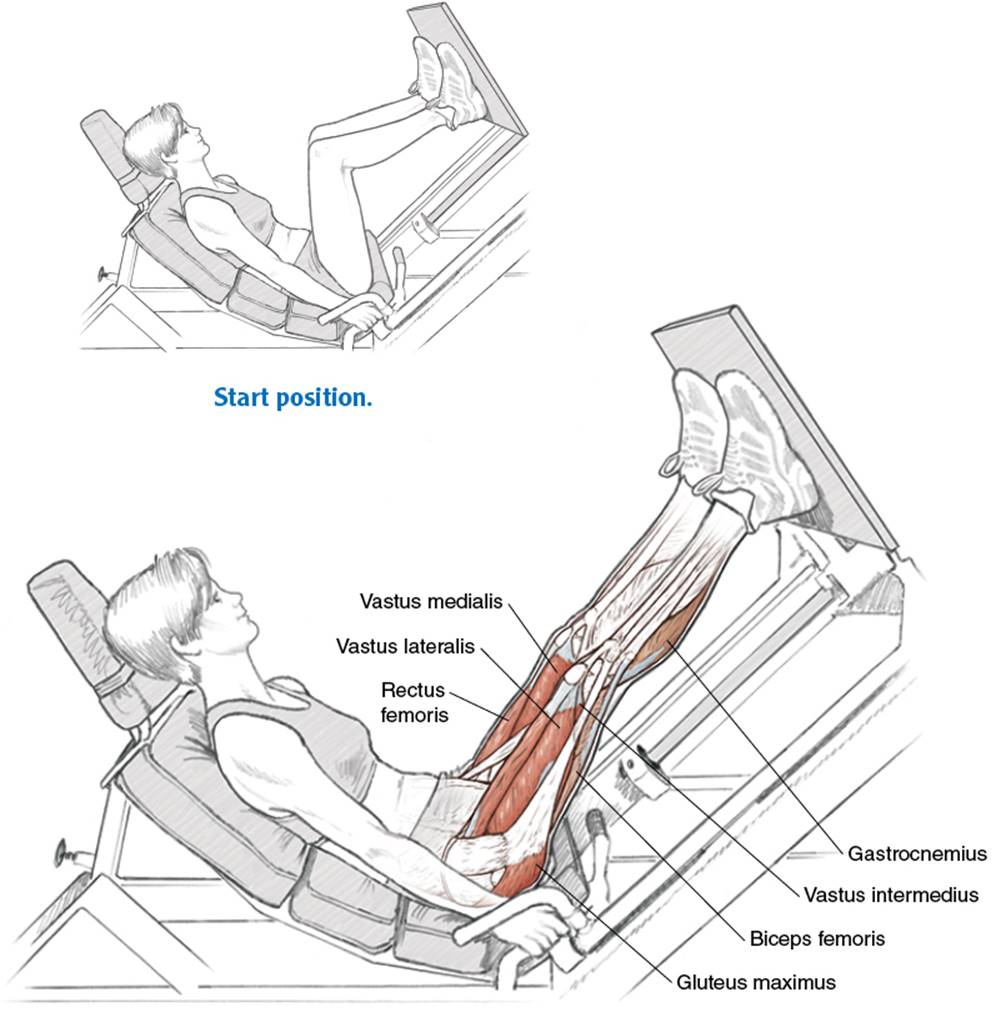
![]()
Safety Tip
This exercise allows for a greater weight to be used because of its reliance on a machine; however, be careful not to add too much weight until proper form is established.
Technique Tip
•Do not hurry the movement, which results in the weight moving past the full range of motion and bouncing back to the legs.
Execution
1. Sit with the feet placed close together (narrower than shoulder-width apart) on the bottom part of the footplate. The back and the head are pressed against the back pads. The safety catch should be on. Flip the safety outward, rendering the weight active. The legs should be prepared to support the weight before the safety is released. Inhale.
2. Concentrating on the hips, glutes, and quads, extend the legs in a fluid movement to full extension by extending both knees.
3. Return to the starting position by gradually flexing the knees, allowing the weight to slowly lower back to the original position.
Muscles Involved
Primary: quadriceps, gluteus maximus
Secondary: gastrocnemius, biceps femoris
Running Focus
The machine incline leg press is a safe exercise to perform, and it can increase strength in the quadriceps and glutes quickly because relatively heavy weights can be used because of the incorporation of the machine. Instead of using energy and strength by heavily incorporating stabilizing muscles (abdominals and adductors), the exercise effectively isolates the quads and glutes, strengthening both sides of the upper leg, helping to avoid muscle imbalances and potential injury.
Altering foot position on the footplate will change the muscle groups impacted. To incorporate more of the glutes, place your feet at the top of the footplate.
Due to its emphasis on the large muscle groups, this exercise creates explosive power for runners. Therefore, it is best used by runners training for shorter events such as a 5K or for track racing in sprints or middle-distance events. The exercise is suitable during the introductory phase of training for all runners because it is a general strength exercise, not a functionally-specific strength exercise.
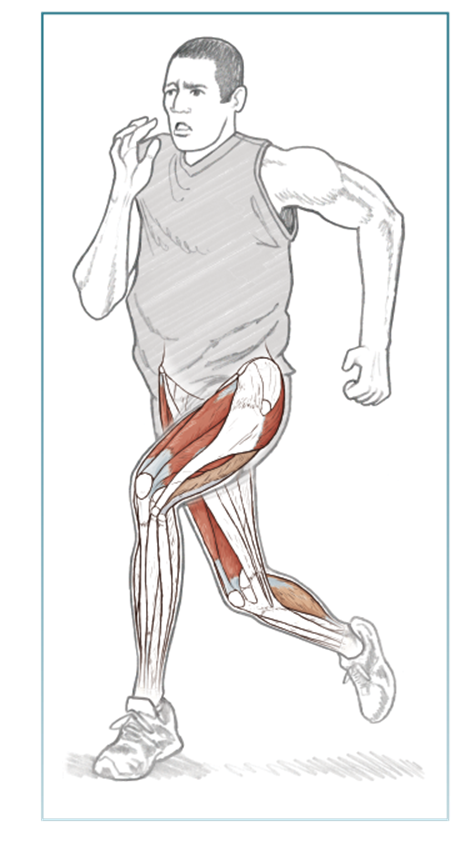
Bent-Leg Good Morning
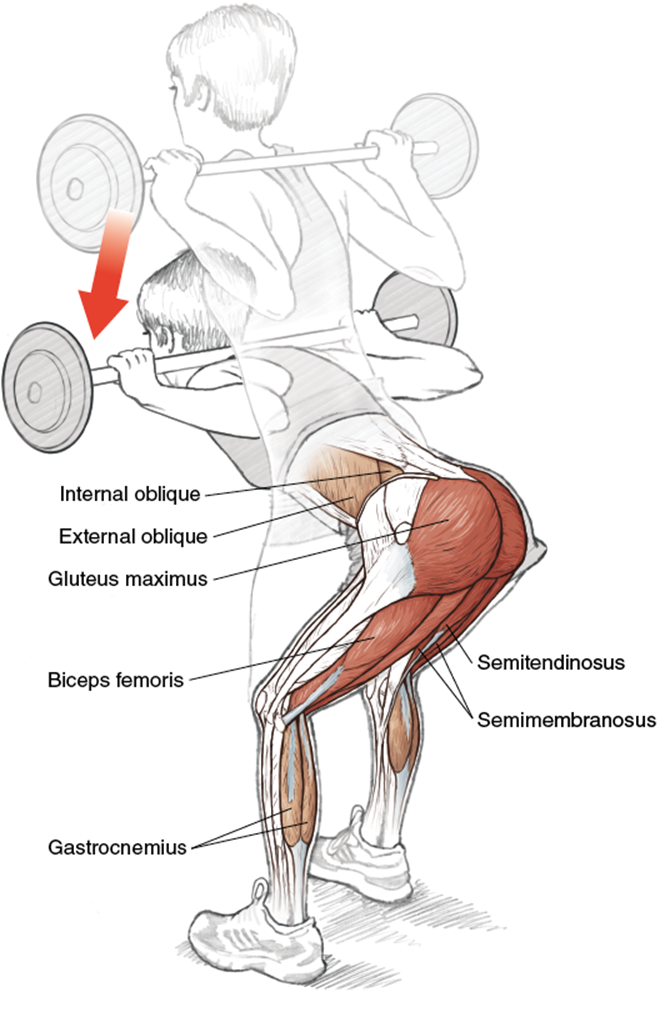
Technique Tip
•Go slowly, and feel the stretch of the lower back and hamstrings.
Execution
1. Stand with good posture, feet shoulder-width apart, grasping a barbell of light weight across the shoulders.
2. Lower the torso by bowing at the waist. The back should be lowered in a single plane, maintaining the lumbar (lower back) curvature. The glutes push outward during the motion. Inhale during the downward movement.
3. Return to the standing position by raising the torso, focusing on the rotation of the pelvis.
Muscles Involved
Primary: hamstrings, gluteus maximus
Secondary: gastrocnemius, external oblique, internal oblique
Running Focus
Many distance runners complain that they feel chronic tightness in the lower back because of the accumulated mileage they have run in training. The jarring impact of a heel strike plus a lack of flexibility has caused many a runner to discontinue training and find another sport. How can you alleviate such a problem? Exercises like the bent-leg good morning, which actually strengthens and stretches the hamstrings in one exercise, work well. Again, like most of the exercises in this book, the bent-leg good morning is a simple exercise to perform, and it has multiple benefits. Aside from strengthening the hamstrings and glutes, it also helps stretch these muscles, helping to loosen the connective tissue between the muscles and the bones of the lower back and the pelvis. This kinetic chain also affects the knees because a more supple lower back pulls less on the hamstrings, in turn allowing the kneecaps to track normally.
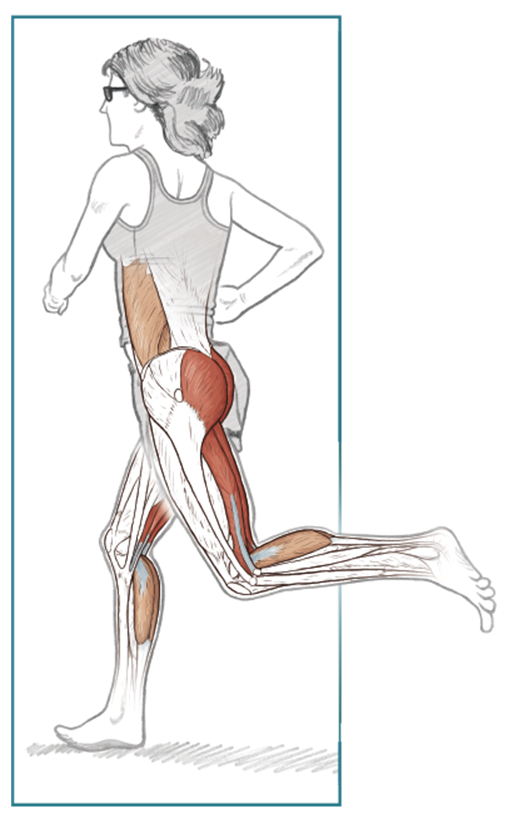
Variation
Straight-Leg Good Morning
The good morning can be performed with straight legs, but runners with chronically tight hamstrings should perform the exercise with bent legs because of the emphasis on hamstring flexibility. Once greater flexibility is attained, the straight-leg version can be incorporated.

Dumbbell Romanian Deadlift

Technique Tip
•The dumbbells should not reach the floor. The slight curve in the lower back should prevent that much movement.
Execution
1. Stand with feet slightly apart and legs slightly bent, with each arm extended downward holding a dumbbell with an overhand grip. There is a slight natural curve in the lower back.
2. Gradually bend at the waist, lowering your back in a single plane while maintaining the natural curve in the back, with the dumbbells almost scraping the quads and knees as you bend.
3. Return to the upright position once you can no longer lower the weight.
Muscles Involved
Primary: hamstrings, gluteus maximus
Secondary: erector spinae
Running Focus
This intense exercise emphasizes the upper legs, specifically the hamstrings and glutes. It is extremely functional in that it works the muscles the way they work when running, more so than the hamstring curl. As has been noted previously, the balance between the larger quadriceps group and the hamstrings is the key to extension and propulsion during the gait cycle. To ensure uninterrupted training, avoidance of injury can be almost guaranteed by performing exercises like the dumbbell Romanian deadlift that help stretch and strengthen the back of the upper legs.
Also, given the demands of fast-paced running on the hamstrings, fast-twitch muscle fibers of the hamstrings are best trained with higher-intensity exercises like the dumbbell Romanian deadlift.

Squat

Execution
1. Using a squat rack, slide under the barbell and center the barbell on the deltoid and trapezius muscles, not the vertebrae of the neck. Feet should be shoulder-width apart and splayed slightly.
2. Inhale deeply, expanding the chest. Maintain the natural curve in the lower back while straightening up and lifting the barbell off the rack.
3. Establish proper position by taking a few steps backward, repositioning the feet and reestablishing the accentuated curve in the lower back.
4. Look toward a point above head level, and initiate the squat action by bending forward at the hips, which will lower the rear. When the thighs are parallel to the floor, straighten the legs and return to the initial position while exhaling.
Muscles Involved
Primary: quadriceps, gluteus maximus, gluteus medius, gluteus minimus
Secondary: hamstrings, external oblique, gastrocnemius
Running Focus
The squat is primarily a quadriceps exercise, but because of its stability demand, it also helps strengthen the core, hamstrings, and muscles of the lower leg. Heavy weight can be lifted, but it is not necessary to make this exercise effective. Squats should be performed during the same session as the dumbbell Romanian deadlift or the good morning to create balance between the front and back of the legs.
Like the machine incline leg press, the squat creates explosive power due to its emphasis on the large muscle groups. Therefore, it is best suited for runners training for shorter events such as the 5K or for track racing in the sprints or middle distance events. Because it is a general strength exercise, not a functionally-specific strength exercise, it is suitable during the introductory phase for all runners. Its emphasis on core stability can aid all runners at every phase of the training progression.
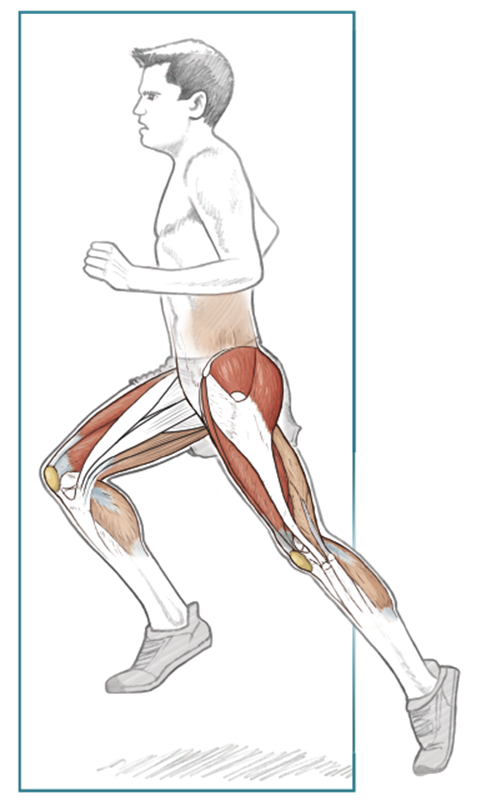
Variation
Single-Leg Squat With Dumbbells
This exercise aids in developing the adductor muscles of the inner thigh. Stand about two to three feet in front of a bench with a dumbbell in each hand. Place the top of one foot (laces of the shoe down) on the bench behind you. Lower your body until the forward leg is bent 90 degrees at the knee and the knee of the rear leg is almost touching the ground. Push back up using the quadriceps muscles of the forward leg. After performing a set of 12 on one leg, switch legs. The weight of the dumbbells does not need to be heavy. Initially, until good form is established, no added weight is necessary.
